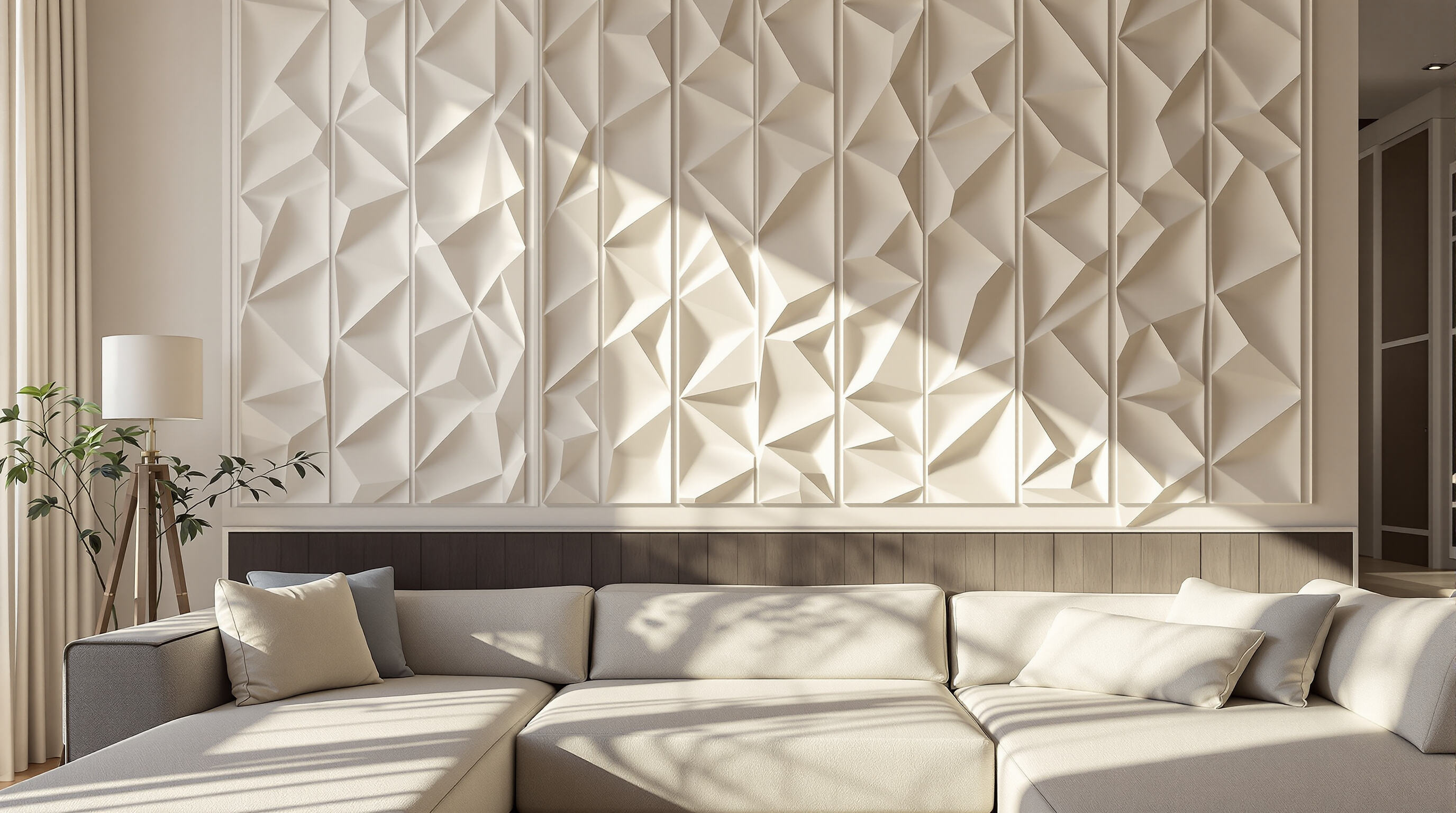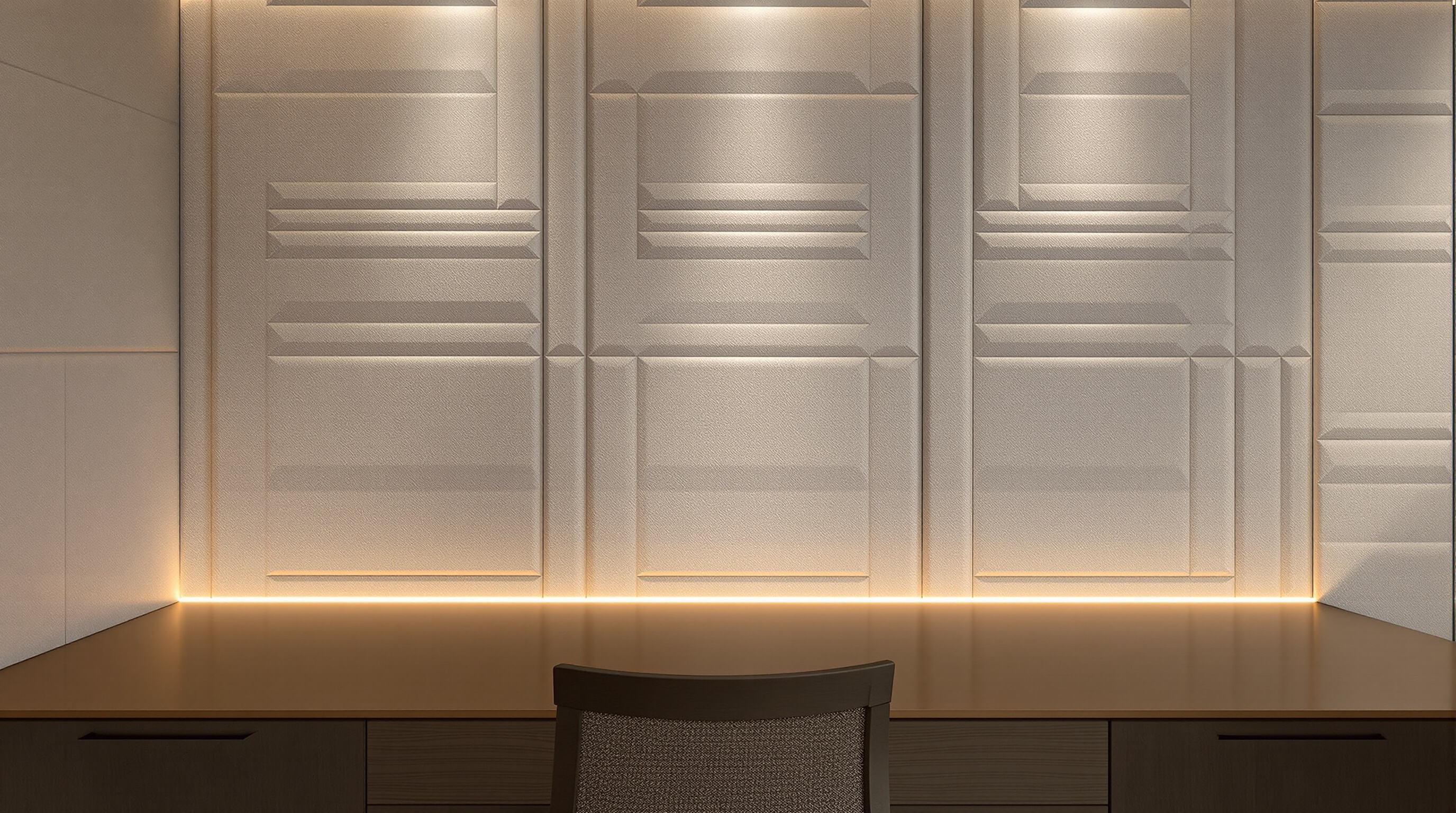چطور؟ پنلهای دیواری 3d افزایش جو آمادهسازی اتاق از طریق عمق و بافت

درک ارتباط بین تابلوهای دیواری 3D و فضای اتاق
نماهای دیواری سهبعدی دیوارهای معمولی و صاف را به چیزی خاص تبدیل میکنند و عمق و بافت واقعی ایجاد میکنند که احساس کلی از اتاق را تغییر میدهند. دیوارهای سنتی تنها در کنار هم قرار میگیرند، اما این نماها با نور و سایه به شیوهای بازی میکنند که فضاهای بزرگتر و جذابتر دیده شوند. بر اساس برخی تحقیقات اخیر از سوی Interior Design Insights، وقتی افراد دیوارهای دارای بافت را میبینند، در واقع اتاق را حدود ۵۵ درصد بزرگتر از اندازه واقعیاش احساس میکنند. این موضوع بسیار قابل توجه است، در حالی که مفهوم آن در نگاه اول بسیار ساده به نظر میرسد. فراتر از ظاهر خوب، این نوع پوششها بر نحوه تجربه فضا تأثیر میگذارند، به گونهای که فضای بهتری برای زندگی روزمره ایجاد میکنند و در عین حال محیطی جذاب را فراهم میآورند.
نقش عمق بصری در تقویت ادراک فضایی
در مورد فضاهای کوچک، اشکال هندسی و آن جزئیات فرورفته خلاقانه واقعاً چشمان ما را فریب میدهند تا فکر کنیم اتاق بزرگتر از آنچه هست، است. روشنایی نیز نقش بزرگی ایفا میکند. روشنایی مناسب میتواند لبههای این تختهها را برجسته کند و به فضا عمق بیشتری دهد. فکر کنید به شیارهای عمودی که در طول دیوارها امتداد دارند، آنها تمایل دارند نگاه را به سمت بالا بکشند و سقف را بالاتر از آنچه هست نشان دهند. از سوی دیگر، آرایشهای افقی در مناطق باریک کارهای شگفتانگیزی انجام میدهند و به آنها عرض اضافی مورد نظر ما را میدهند. ترکیب این عناصر طراحی، بدون اینکه نیاز باشد دیوارها را بکنیم یا هزینههای گزافی برای بازسازی کنیم، چیزی واقعاً خاص ایجاد میکند. بسیاری از مالکان خانه این رویکرد را زمانی که با پیشانی محدود مربع فوت مواجه هستند ولی هنوز میخواهند فضای زندگیشان باز و دوستانه به نظر برسد، مؤثر مییابند.
تأثیر بافت و شکل بر فضای هیجانی
بافت نقش کلیدی در شکلگیری پاسخهای هیجانی را ایفا میکند:
- الگوهای صاف و موجدار، آرامش را در خوابخانهها افزایش میدهند
- فرمهای هندسی جسورانه فضاهای نشیمن را پویا میکنند
- پوششهای چوبی ارگانیک گرمی را به دفاتر میآورند
یک مطالعه عصبشناسی در سال 2023 نشان داد که سطوح دیوار مبتنی بر لمس، نسبت به دیوارهای رنگی صاف، مارکرهای استرس را 34٪ کاهش میدهند و مزایای روانی طراحی ابعادی را تأیید میکنند.
مطالعه موردی: دگرگونی اتاق نشیمن با استفاده از پنلهای 3D
در یک آپارتمان شهری ۲۵۰ فوت مربعی، پنلهای سهبعدی ششضلعی به رنگ عاجی پشت مبل راحتی نصب شدند. نتایج پس از نصب نشان داد:
| METRIC | بهبود |
|---|---|
| اندازه ادراکی اتاق | +40% |
| نگهداشتن نور محیطی | +28% |
| پژواک صوتی | -19dB |
ساکنان احساس آرامش بیشتر و بهبود در وضوح گفتار را گزارش کردند که نشان میدهد چگونه صفحات سهبعدی همزمان بر روی فضای محیط و عملکرد آکوستیکی تأثیر میگذارند.
انعطافپذیری طراحی صفحات دیواری سهبعدی در دکوراسیونهای مدرن
انعطافپذیری زیباییشناختی: ایجاد فضاهای مدرن، آرامبخش یا دراماتیک
تختههای دیواری 3D در پاسخگویی به نیازهای مختلف طراحی برجسته هستند و چه کسی که به دنبال چیزی فوقالعاده مدرن و ساده باشد و چه کسی که فضایی آرامبخش و شبیه به یک سفر میخواهد، به خوبی عمل میکنند. مواد مختلفی مانند گچ، MDF و تختههای MGO دوستدار محیطزیست امکان خلاقیت را در سبکهای متنوع فراهم میکنند. این شامل میشود خطوط تیز و تمیز برای آپارتمانهای شهری، منحنیهای نرم که حس اسپا را در حمام ایجاد میکنند یا اشکال هندسی قوی که برای دفاتر و فروشگاهها مناسب است. بر اساس دادههای اخیر انجمن طراحی داخلی (۲۰۲۴)، حدود دو سوم طراحان داخلی اکنون گزینههای انعطافپذیر مانند این تختههای 3D را انتخاب میکنند، چون مشتریان به طور مداوم در مورد آنچه میخواهند در فضای زندگیشان تغییر ذهن میدهند.
الگوهای هندسی و سطوح بافتدار برای تأثیر بصری
برش دقیق با ماشینهای CNC امکان طراحیهای پیچیده مانند شانهای، ششضلعی و انواع الگوهای تکراری را فراهم میکند که دیوارهای عادی را به چیزی تبدیل میکنند که شبیه به اثر هنری متحرک است. وقتی نور از زوایای مختلف در طول روز به این اشکال میتابد، سایهها روی آنها میچرخند و احساس شگفتانگیزی از عمق ایجاد میکنند. بافت نیز اهمیت دارد. سطوح بتنی مسواکخورده احساس خشنی زیر انگشتان ایجاد میکنند در حالی که مواد بافتهشده حس کاملاً متفاوتی را هنگام لمس فراهم میکنند. به دلیل ترکیبی از جذابیت بصری و تعامل فیزیکی، پنلهای دیواری سهبعدی در فضاهای مسکونی مدرن با فضای باز یا در محیطهای کسبوکاری که شرکتها میخواهند با چیزی تازه و شیک اما در چارچوب محدودیتهای بودجهای، بازدیدکنندگان را تحت تأثیر قرار دهند، عملکرد بسیار خوبی دارند.
پنلهای رنگی و هنری به عنوان عناصر طراحی برجسته
تابلوهای سهبعدی فقط به رنگهای معمولی محدود نمیشوند. این تابلوها به طراحان این امکان را میدهند تا با بلوکهای جسورانه رنگی، جزئیات براق فلزی و انواع الگوهای انتزاعی برای برجسته کردن سبک شخصی خود بازی کنند. یک مطالعه که در سال گذشته در کنفرانس طراحی و هیجان (Design and Emotion Symposium) ارائه شد، چیزی جالبی نیز کشف کرد: دیوارهای هنری به نظر میرسد حدود 27% باعث افزایش خلاقیت در افراد شوند. آیا به دنبال گرادیانهایی هستید که از یک رنگ به رنگ دیگر تغییر میکنند؟ چه میشود اگر جزئیات دسترنگی یا حتی یک تصویر بزرگ دیواری بسازید؟ این ویژگیها روی تابلوهای سهبعدی بسیار خوب عمل میکنند و در عین حال ساختار زیرین دیوار را تضعیف نمیکنند. نتیجه چیست؟ دیوارهایی که فقط عملکردی نیستند بلکه به اشیاء هنری واقعی تبدیل میشوند.
سبکهای روند: اسلات (Slat)، شیپلاپ (Shiplap) و طرحهای تابلوی سهبعدی بزرگمقیاس
سبکهای فعلی بر مقیاس و تضاد لمسی تأکید دارند:
- طرحهای اسلات (Slat) : تابلوهایی با الهام از چوب عمودی یا افقی که ریتمی به اتاقهای خواب و دفاتر میدهند
- تغییرات شیپلاپ (Shiplap) : با شکافهای نامتقارن دوباره طراحی شده برای یک ظاهر مدرن از سبک کشاورزی
- Панеляهای بزرگتر امکانپذیر میکند : فرمتهای تا 8 × 4 درزهای مینیمم را فراهم میکنند و برای دیوارهای کانونی بدون درز ایدهآل هستند
این سبکها در نشریههای معماری در فهرست نوآوریهای برجسته مواد 2025 به دلیل تعادل بین تأثیر بصری و سادگی عملکردی قرار دارند.
کاربردهای اختصاصی برای اتاق: اتاقهای نشیمن، خواب و دفتر کار
استفاده از پنلهای دیواری 3D در اتاقهای نشیمن و خواب برای افزایش فضای مطبوع
اگر پنلهای سهبعدی به مراکز تفریحی و دیوارهای رسانهای اضافه شوند، اتاقهای نشیمن کاملاً دگرگون میشوند. این پنلها از نظر بصری برجسته هستند و فضای پویاتری ایجاد میکنند. اتاقهای خواب هم از مواد نرمتر بهره میبرند. پارچههای بافتهشده یا بافتهای شبیه به پارچه را در نظر بگیرید که فضای اتاق را دربر گرفته و آن احساس خانگی که مردم دوست دارند را ایجاد میکنند. بر اساس تحقیقات اخیر منتشرشده در نشریه طراحی داخلی در سال 2023، سطوح با بافت واقعی حدود 23 درصد بیشتر از دیوارهای صاف باعث کاهش استرس درکشده میشوند. این موضوع توضیح میدهد که چرا بسیاری از مالکان خانه به این نوع از سطوح در مناطق خواب خود که استراحت در آنها اصلیترین هدف است، علاقهمند هستند.
ایجاد دیوارهای کانونی و عناصر تزئینی در فضاهای مسکونی
پنلهای سهبعدی هندسی به عنوان نقاط کانونی چشمگیری پشت مبلها یا تختها عمل میکنند و با استفاده از نور و سایه توجه را به خود جلب میکنند. الگوهای نامتقارن روی دیوارهای اطراف شومینه یا ورودی جریان دید را هدایت میکنند. برای تأثیری ظریفتر، طرحهای با ک relief کم (با عمق 0.5 اینچ) در مناطق باریک مانند راهروها به خوبی عمل میکنند و جالبیت ایجاد میکنند بدون اینکه فضای را فراموش کنند.
انتخاب طرحهای 3D آرامکننده برای محیطهای خواب آرامبخش
پنلهای تراز افقی با موتیفهای منحنی الهامگرفته از طبیعت آرامش را در خوابگاهها افزایش میدهند. ترکیب این طرحها با مواد جاذب صدا مانند پارچ PET-felt راحتی صوتی را بهبود میبخشد و میتواند میزان نویز را تا 30 دسیبل کاهش دهد (دادههای آزمایش صوتی، 2023). روکشهای بیدرخشندگی خنثی همچنین به آرامی کمک میکنند در حالی که عمق دید را حفظ میکنند.
ادغام پنلهای دیواری چوبی سهبعدی در طراحی دفتر کار برای ایجاد گرما و تمرکز
نماهای سهبعدی چوبی با طرح تیغههای عمودی بهصورت بصری دفاتر کاری خانگی را زیباتر میکنند و خستگی ناشی از صفحه را خنثی میکنند. گزارش طراحی فضای کاری 2024 میلادی نشان داد که 68 درصد از کارکنان دورکار ترجیح میدهند از پایانههای چوبی با بافت بهمنظور افزایش تمرکز استفاده کنند. زمانی که این نماها با روشنایی وظیفهای همراه شوند، ابعاد آنها را بدون ایجاد بازتاب برجسته میکنند و به حفظ تمرکز در طول ساعات طولانی کاری کمک میکنند.
مزایای عملکردی: صدای بهینهشده، روشنایی و کنترل فضای داخلی

نماهای دیواری سهبعدی صوتی: ترکیب کنترل صدا با طراحی داخلی
نماهای سهبعدی صوتی با جذب تا 70 درصد از صدای محیط در خانهها و دفاتر کاری به مبارزه با آلودگی صوتی کمک میکنند. مواد ادغامشده مانند فوم یا پارچههای بازیافتی بهخوبی از انتشار صدا میکاهند و درعینحال جذابیت بصری را حفظ میکنند. ساختارهای هندسی آنها امواج صوتی را پراکنده میکنند و به همین دلیل در فضاهای باز و بدون دیوار برای حفظ حریم خصوصی و وضوح صدا مناسب هستند.
ادغام الئیدی و ایجاد اثرات روشنایی محیطی برای بهبود حالت روحی
نوارهای LED فرورفته در شیارهای پانل دیوارها را به منابع نور غیرمستقیم تبدیل میکنند و با کاهش میزان درخشندگی، بافت را برجسته میکنند. دمای رنگ سفید گرم (2700-3000K) فضای آرامشی در خوابخانهها ایجاد میکند، در حالی که دماهای سردتر (4000-5000K) هوشیاری را در فضاهای کاری افزایش داده و نورپردازی را با نیازهای عملکردی تطبیق میدهند.
پانلهای چندمنظوره: عملکرد صوتی همراه با بیان هنری
سیستمهای 3D مدرن صدا را کنترل کرده و طراحیهای قابل تنظیم را با هم ترکیب میکنند. ویژگیهایی مانند الگوهای برش لیزری برای پراکندگی بهینه، نیشهای فرورفته برای گیاهان یا دکوراسیون، و سطوح مغناطیسی برای تغییر آثار هنری، اجازه میدهند دیوارها با نیازهای کاربر تغییر کنند، در حالی که کارایی صوتی حفظ میشود.
تعادل بین بافت و عملکرد برای جلوگیری از بیشفشار آوردن به فضای اتاق
در حالی که صفحات سهبعدی فضای داخلی را غنیتر میکنند، استفاده بیش از حد از آنها میتواند منجر به اشباع حسی شود. طراحان پیشنهاد میدهند که دیوارهای تزئینی را تا 25-35 درصد از مساحت کل در اتاقهای کوچک محدود کنید و در مناطق پرتردد، از سبکهای صافتر و با برجستگی کم استفاده نمایید. در خوابخواب، طرحهای منحنی با ترکیبات پشم جاذب صدا، پژواک را کاهش داده و فضای آرام را حفظ میکنند.
سوالات متداول
صفحات دیواری سهبعدی چه مزایایی برای فضاهای کوچک فراهم میکنند؟
صفحات دیواری سهبعدی میتوانند با بازی با نور و سایه، توهم فضای بزرگتری ایجاد کنند و فضاهای کوچک را گستردهتر و بازتر نشان دهند.
آیا صفحات دیواری سهبعدی برای تمام اتاقهای خانه مناسب هستند؟
بله، صفحات دیواری سهبعدی انعطافپذیر هستند و میتوانند در پذیرایی، خوابخواب و دفاتر و سایر فضاها استفاده شوند تا خواص بصری و صوتی فضا را بهبود بخشند.
صفحات دیواری سهبعدی چگونه فضای یک اتاق را بهتر میکنند؟
با اضافه کردن بافت و عمق، صفحات دیواری سهبعدی میتوانند فضای یک اتاق را دگرگون کنند و با بازی با نور و سایه، اتاق را پویاتر و جذابتر کنند.
آیا پنلهای دیواری 3D در کاهش نویز کمک میکنند؟
بله، پنلهای 3D صوتی برای جذب صدا طراحی شدهاند و میتوانند نویز محیطی را کاهش داده و کیفیت کلی صوت در یک اتاق را بهبود بخشند.
برخی از سبکها و مواد متداول برای پنلهای دیواری 3D چیست؟
سبکهای محبوب شامل پنلهای شیاردار، شیپلاپ و پنلهای بزرگتر از اندازه معمولی هستند، در حالی که مواد از جیپسوم گرفته تا تختههای MGO دوستدار محیط زیست را دربر میگیرند. این عناصر طراحی بسیار قابل سفارشیسازی هستند تا با سلیقهها و سبکهای داخلی مختلف تطبیق پیدا کنند.
فهرست مطالب
- چطور؟ پنلهای دیواری 3d افزایش جو آمادهسازی اتاق از طریق عمق و بافت
- انعطافپذیری طراحی صفحات دیواری سهبعدی در دکوراسیونهای مدرن
- کاربردهای اختصاصی برای اتاق: اتاقهای نشیمن، خواب و دفتر کار
- استفاده از پنلهای دیواری 3D در اتاقهای نشیمن و خواب برای افزایش فضای مطبوع
- ایجاد دیوارهای کانونی و عناصر تزئینی در فضاهای مسکونی
- انتخاب طرحهای 3D آرامکننده برای محیطهای خواب آرامبخش
- ادغام پنلهای دیواری چوبی سهبعدی در طراحی دفتر کار برای ایجاد گرما و تمرکز
- مزایای عملکردی: صدای بهینهشده، روشنایی و کنترل فضای داخلی
- سوالات متداول

